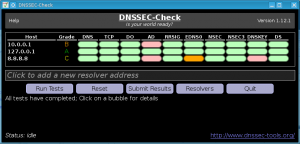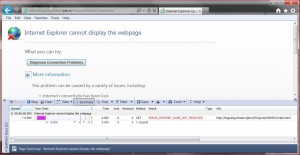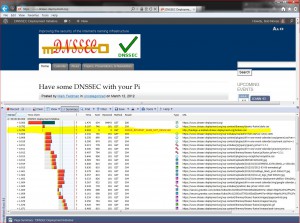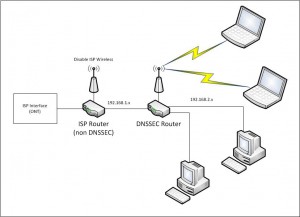Archive for category Adoption
How Well Do Your Resolvers Support DNSSEC?
Posted by Wes Hardaker in Adoption on March 7, 2013
You probably use multiple DNS resolvers on multiple devices through the course of the day, as you wander to and from home, work, coffee shops, etc. Your desktop uses them. Your laptop uses them. Even your cellphone and tablets use them. But how well prepared are all of these resolvers for DNSSEC? Can they assist your applications in determining which DNS records have been secured or not?

By using the DNSSEC-Check tool from the DNSSEC-Tools project, you can find out! This handy utility will test your neighboring resolvers, and any additional ones you provide it, for their support of critical DNSSEC required protocol features. After testing is done, it will even provide you with a letter grade for each resolver. Ideally, every resolver should have an A grade (indicating that not only does it support DNSSEC queries, but is a DNSSEC validating resolver itself). But if not, the colored bubbles will quickly let you know exactly which features a resolver might be missing to be fully DNSSEC compliant.
Additionally, the DNSSEC-Check utility lets you submit your anonymized results to a results collection server. These collected results let the DNSSEC-Tools project track the state of world deployment over time. So, once you find out your local resolvers are not “quite up to the task”, then you can keep checking over time to see if they’ve been updated (or better yet, update them yourself if you can!). Then resubmit the results once things have changed! The results of this collection engine can be found on the DNSSEC-Check Results page. Submitting data is entirely optional, so thanks in advance if you are willing to help us out!
Is a $70 router fast enough for DNSSEC?
Posted by Olafur Gudmundsson in Adoption, Case Studies, DNSSEC on March 22, 2012
In a blog post a few days ago, Bob Novas talked about configuring an inexpensive home router as a DNSSEC validator for a home/small office network.
Such a router has much less computational power than most computers today, so many people assume it is not fast enough to do DNSSEC validation. To test that assumption, I ran the router through a set of tests designed to measure DNS and DNSSEC validation performance. I ran each of the following tests in sequence against the router with DNSMASQ (the default, non-validating forwarding resolver used by OpenWrt), Unbound without validation, and Unbound with validation:
- Test #1 Cold cache: query for X signed names from 2 different zones
- Test #2 Warm cache: query once for each of the names in #1
- Test #3 Mixed case query for the names in cache and intermingle 30% queries for names not in cache
- Test #4 Remote Ask for 50 nonexistent names in .gov
In tests 1-3, the names queried are from zones served by authoritative servers on the same LAN, minimizing network delays.
The reason I have the value X above is that I use different values depending on the speed of the device under test. The goal of the tests is to run experiments #1 and #3 for just long enough to get meaningful results.
When running without DNSSEC, DNSMASQ and Unbound performed about the same In the Cold test — around 700 queries/second.
Unbound was six times faster on the Warm test since it caches responses and DNSMASQ doesn’t. Unbound was two faster on Mixed test for the same reason.
With DNSSEC turned on, Unbound was able to handle about 140 validated queries/second, which is quite fast. This is with answers that are signed by a 1024-bit RSA key. It ran at the same speed as it did without DNSSEC in the Warm case.
This performance is more than enough for a home or small office.
When comparing the results for the Remote test, validating Unbound finished in about seven seconds while non-validating DNSMASQ took about ten. Network delay, not validation time, dominates the time to perform this test. In non-test situation, DNSSEC validation thus will not be a bottleneck when the doing lookups from the Internet.
A validating recursive resolver on a $70 home router
Posted by Bob Novas in Adoption, DNSSEC, Technical guides on March 15, 2012
As an experiment, I installed a validating recursive resolver on a home/SOHO router. I also set the router to advertise this resolver in DHCP as the DNS server for the LAN served by the router. The experiment was a resounding success — the clients on the router LAN only receive Secure or Provably Insecure DNS responses and do not receive Bogus responses.
I was able to verify this by navigating to a bogus addresses. For example, here is a screen shot of navigating to a domain with a bogus signature (http://bogussig.dnssec.tjeb.nl). If you are on a non-validating network, you will be able to resolve this link. If your network is validating, however, you should get an error if you click the link.
The HttpWatch browser plugin shows that the DNS query for this address very quickly returns an error.
So, how did I do this? I started with a Buffalo WZR-HP-G300NH v2 router, which I purchased online for just under US$70. The router runs a customized version of the DD-WRT Open Source software out of the box. The router has 32MB of NVRAM and 64MB of RAM. The basic configuration with an Unbound recursive resolver requires about 10MB of NVRAM, so this router has more than enough storage.
A few words of caution. Not all routers are suitable — you need to have a router that is supported by OpenWRT and the router needs to have enough flash memory. Also, you may lose any special features that are included in the manufacturer’s firmware. For the router I used, I lost the “movie engine” feature and the ability to support a file system on the router’s USB port. I could have loaded more packages from OpenWRT to support a file system. Finally, there is a risk that you will brick the router — i.e., turn it into a paperweight. You’ll need some level of expertise with technology and a platform that supports telnet, ssh and scp (e.g., Cygwin on Windows, or a Mac or Linux box).
Because of the greater ease of configuration that it offers, I reflashed the router with the OpenWRT router software. Then I loaded and configured Unbound, a BSD-licensed recursive resolver and was up and running.
Here are the specifics of how I accomplished this:
- I downloaded the right firmware image for the router from the OpenWRT nightly build site. For the Buffalo WZR-HP-G300NH2 router, I used this build for the squashfs file system for a system upgrade. The system upgrade is because I was going from a DD-WRT build to an OpenWRT build. Other firmware images are available for this router that are specific to other circumstances. If you are not flashing this specific router, you will need to establish the right firmware to use for yourself.
- I connected my PC to a LAN port on the router. I set the PC to use an address on the same subnet as the router – in my case 192.168.1.10 as the router is at 192.168.1.1.
- I pointed my browser at the router, set a password, and logged in to the router’s Web UI.
- I navigated to the Administration/Services page and enabled the SSH daemon. At the same time I set up the authentication for SSH.
- From a terminal window on my PC, I copied the OpenWRT firmware to the router.
scp openwrt-ar71xx-generic-wzr-hp-g300nh2-squashfs-sysupgrade.bin [email protected]:/tmp
- I then logged into the router via ssh to flash OpenWRT onto the router in place of the supplied dd-wrt:
ssh [email protected] cd /tmp mtd -r write openwrt-ar71xx-wrz-hp-g300nh2-squashfs-sysupgrade.bin linux
- I waited for a good long while. When the red light stopped blinking, I had successfully flashed the router. It did not yet have a Web UI, but I was able to access it using telnet.
- I used telnet to acces the router with no username or password and set a password. This should disable telnet and enable ssh with that password (username root):
telnet 192.168.1.1 set a password when prompted
- I connected an Ethernet cable from my home LAN to the router’s WAN port (you could also connect the cable directly to your cable or DSL modem).
- I ssh’d into the router and loaded and installed the router’s Web UI, called luci:
ssh [email protected] opkg update opkg install luci ⁄etc⁄init.d⁄uhttpd enable ⁄etc⁄init.d⁄uhttpd start
- At this point I was able to login to the router’s Web UI by pointing my browser to 192.168.1.1. On my first login, I needed to set a username and password. I found that no matter what username I set, I always needed to use the username root to login to the router via ssh. It did use the password I set, however.
- I think the best thing to do next is to move the router’s LAN subnet to another subnet. My primary subnet (i.e., the one my ISP’s router provides and the one I have plugged into the router I’m working on’s WAN port) is 192.168.1.x. I logged in to the router’s Web UI and moved the router’s LAN to 192.168.2.1. This avoid IP address conflict between the two subnets. Since my PC is plugged into the LAN port of the router, I had to change my PC’s address to something like 192.168.2.10 so it can talk to the router once it’s on 192.168.2.1.
- I then ssh’d back into the router and installed unbound (This can also be done this using the Web UI from the System/Software page). I ssh’d into the router and used opkg to install Unbound:
ssh [email protected] opkg install unbound
- I enabled Unbound at startup by navigating a browser to the router’s System/Startup page and clicking on Unbound’s Enabled button to turn it to Disabled.
- I disabled dnsmasq’s (the default DHCP and DNS server on the router’s) DNS function by navigating the browser to the Network/DHCP and DNS/Advanced page and setting DNS Server Port to 0 (zero).
- Finally, from my ssh session, I told dnsmasq to advertise the router (unbound, really) as the DNS server in DHCP responses:
uci add_list dhcp.lan.dhcp_option="6,192.168.2.1" uci commit dhcp ⁄etc⁄init.d⁄dnsmasq restart
At this point, my router was up and running, dnsmasq’s DHCP was advertising the router as the DNS server, and Unbound was running as a recursive resolver on the router. All computers I put on the 192.168.2.1 router’s LAN that auto-configure using DHCP used this router’s unbound resolver for DNS, and are protected by DNSSEC. My network is configured as shown in the figure below.
One thing we noticed after running the router for a few days — be sure to leave NTP running on the router. In our case, we turned NTP off for some debugging and forgot to turn it back on (NTP is on the OpenWRT System/System page, under “Enable buildin NTP Server”.) After a few days, the router’s time was far enough off to cause validation to fail. Time is important for validation to work correctly because DNSSEC signatures have inception and expiration times.
We plan on doing some benchmarking of Unbound’s performance on this platform and on doing similar experiments with other routers. Email us at info @ dnssec-deployment.org with your experience doing this or any questions or feedback.
Some Fragments are more equal than other fragments
Posted by Olafur Gudmundsson in Adoption, DNSSEC, Technical guides on March 9, 2012
[Update of a post from January 28’th 2010 to fix broken links and add details]
My last post was about being able to receive fragmented DNS answers over UDP.
Last week (that is on January 20’th 2010) , I did a minor revision to a script of mine that checks to see if all of the name servers for a zone have the same SOA record and support EDNS0. This will indicate whether the servers are in sync and can serve DNSSEC. During testing of the updated script all the servers for .US timed out. This had never happened before, but .US turned on DNSSEC last month, so I started to investigate.
First I issued this query in dig format:
dig @a.gtld.biz US. SOA +dnssec +norec
Time-out confirms my script is reporting correctly. Then I tried again: (not asking for DNSSEC records)
dig @a.gtld.biz US. SOA +norec
This worked, the server is alive and the question has an answer, Then I tried getting the DNSSEC answer using TCP:
dig @a.gtld.biz US. SOA +norec +dnssec +tc
This gave me a 1558 byte answer (too large for one UDP packet) so fragmentation is needed to get over Ethernet links. But my system can handle big answers, so what’s wrong?
At this point I had number of questions:
- “What is NeuStar (the .US operator) doing?”
- “Are any other signed domains showing the same behavior?”
- “Are the fragments from these servers different from other fragments?”
First things first; “What is .US returning in their SOA answer?”
- In the answer section they give out the signed SOA record.
- In the authority section there is a signed NS set.So far, so good.
- In an additional section there are the glue A and AAAA records for the name servers, AND a signed DNSKEY set for the US. zone.
Conclusion: NeuStar is not doing anything wrong, but there is no need for the DNSKEY in the additional section. As this is turning up some fragmentation issues, I consider this a good thing.
At this point I moved on to the second question; “Is anyone else showing the same behavior?” All the signed TLD’s that I queried returned answers of less than 1500 bytes, so no fragmentation was taking place. I modified my script to ask for larger answers in order to force fragmentation. Instead of asking for type “SOA”, I ask for type “ANY”. For signed domains this should always give answers that are larger than 1500 bytes, since signed SOA, DNSKEY, NS and NSEC/NSEC3 are guaranteed to be in the answer and possibly others. Now things got interesting.
Almost all of the signed TLDs had one or more servers that timed out. .Org, for example, had 4 out of 6, .CH had 2, and .SE had one. So the issue is not isolated to anything that the .US operator is doing, but an indicator of something bigger.
I copied my script over to another machine I have and ran it there, and lo and behold, I got answers – no time-outs. The first machine is a FreeBSD-7.2 with PF firewall, the second machine is an old FreeBSD-4.12 with IPFW.
Now on to the next question; “Are the fragments different?” A quick tcpdump verified that answers were coming back. I fired up wireshark tool to do full packet capture. To make the capture smaller I activated the built-in DNS filter, and ran my script against the .ORG servers and the .US servers.
Looking at the DNS headers there was nothing different, and the UDP headers looked fine. On the other hand I noticed that the IP header flags field from the servers that timed out all had DF (Do Not Fragment) set on all packets, and on the first packet in the fragmentation sequence both the DF and MF (More Fragments) bits were set. MF tells IP that this is a fragmented upper layer packet and this is not the last packet. At this point I wondered if somehow this bit combination was causing problems in my IP stack or the firewall running on the host.
I disabled the PF firewall and suddenly the packets flowed through. After doing some searching on the Internet I discovered that I can tell PF to not drop these packets.
My old PF configuration had
scrub in all
The new one is
scrub in all no-df
Removing the scrub command also allows the packets to flow, but I do not recommend that solution.
I started asking around to find out what is causing the DF flag to be set on UDP packets, and the answer was “Linux is attempting MTU discovery”. I also noticed that for the last 2 years Bind releases have added code to attempt to force OS to not set DF on UDP packets. See file: lib/isc/unix/socket.c look for IP_DONTFRAG.
Conclusion: the tools I mentioned in the last post do not test to see if these malformed fragments are getting through. I have updated my perl script to ask for a large answer from an affected site, and to report on that. Please let me know if you have the same issue and what you did to fix it on your own systems and firewalls.
DNSSEC signed answers from L root server
Posted by Olafur Gudmundsson in Adoption, DNSSEC, News on January 27, 2010
The first root server (L) has started to serve up a signed version of the root zone. This is the first step in the live testing that will lead to a production signed root by the middle of the year. For information on the status of the root signing process visit: http://www.root-dnssec.org/
The root is intentionally publishing bogus signing keys, so the answers are not verifiable. Once the testing completes the actual keys will be published.
Current DNSKEY set advertised:
. 86400 IN DNSKEY 256 3 8 AwEAAa1Lh++++++++++++++++THIS/IS/AN/INVALID/KEY/AND/SHOULD/NOT/BE/USED/CONTACT/ROOTSIGN/AT/ICANN/DOT/ORG/FOR/MORE/INFORMATION+++
+++++++++++++++++++++++++++++++++++++++++++++++8
. 86400 IN DNSKEY 257 3 8 AwEAAawBe++++++++++++++++THIS/IS/AN/INVALID/KEY/AND/SHOULD/NOT/BE/USED/CONTACT/ROOTSIGN/AT/ICANN/DOT/ORG/FOR/MORE/INFORMATION+++
++++++++++++++++++++++++++++++++++++++++++++++++++++++++++++++++++++++++++++++++++++++++++++++++++++++++++++++++++++++
++++++++++++++++++++++++++++++++++++++++++++++++++++++++++++++++++++++++++++++++++++++++++++++++++++8=
. 86400 IN RRSIG DNSKEY 8 0 86400 20100204235959 20100121000000 19324 . NO9bHgWYB3wQlVZXQKwDGUjTgIyfz1i8aWH8nBlT5isnYbr6PTfR4fWlSx8+avFfR0fVekauaQelKOyiUav4H9Y1AZ2OBguu7RjozQu1qErKboWd1NglIIOGar0Ol4Ur9+
4bo2LSxjp/X4ESypW0lX04z5uB6DZZei1zafzRGUnLIMdV9xdKEOJrm9UCKvYK5g8bjRq8KA8vT+
pidexZMrBQ3ie8R9daf/s6VK7zUJK0jF1vqhPbZFSQmBpJUlxh4VnOv7nnhcq4Moj49wqmNxKRqfvSwHAJBG6dEgShnlu/rfVsdxfFUCjIGX8YnSC7lYqODwgUGh+i/arA AK+bzg==
U.S. federal DNSSEC deployment lags behind deadline
Posted by Denise Graveline in Adoption, DNSSEC, Meetings and Workshops on January 21, 2010
Based on monitoring data from Secure64, Network World reported today that only 20 percent of U.S. federal agencies have deployed DNSSEC in time to meet a mandate from the White House Office of Management and Budget. From the article, Initiative partner Steve Crocker, CEO of Shinkuro, Inc., said:
Missing the mark by one year is pretty good news in this business…There is a gradual tightening of security going on up and down the Internet protocol stack. DNSSEC isn’t the be-all-and-end-all, but it’s an important piece. The technical community has been working on DNSSEC for 20 years. The top part of .gov is signed, and now we’re seeing the other pieces coming along.
U.S. federal deployment will be the topic of the DNSSEC Deployment Coordination Initiative’s special one-day program at FOSE 2010 on March 24. Go here to see an updated program and links to register or exhibit.
Educause factsheet highlights DNSSEC
Posted by Denise Graveline in Adoption, DNSSEC, Technical guides, Uncategorized on January 15, 2010
 Educause has just published a two-page factsheet on 7 things you should know about DNSSEC, aimed at college and university information technology officials. Noting that “DNSSEC can be an important part of a broad-based cybersecurity strategy,” the fact sheet explains that security has special implications for institutions of higher education:
Educause has just published a two-page factsheet on 7 things you should know about DNSSEC, aimed at college and university information technology officials. Noting that “DNSSEC can be an important part of a broad-based cybersecurity strategy,” the fact sheet explains that security has special implications for institutions of higher education:
Colleges and universities are expected to be “good Internet citizens” and to lead by example in efforts to improve the public good. Because users tend to trust certain domains, including the .edu domain, more than others, expectations for the reliability of college and university websites are high. To the extent that institutions of higher education depend on their reputations, DNSSEC is an avenue to avoid some of the kinds of incidents that can damage a university’s stature.
GCN: DNSSEC among top 10 technologies for 2010
Posted by Denise Graveline in Adoption, DNSSEC, News on January 15, 2010
Adding to our compilation of observers who’ve put DNSSEC on their lists of 2010 trends to watch, Government Computer News has put DNSSEC on its list of 10 Technologies to Watch in 2010. Noting that the DNS security extensions “add an important level of assurance,” the article noted:
Leading by example, the U.S. government has helped to spur adoption. Following disclosure last year of a serious vulnerability in the DNS protocols, the Office of Management and Budget mandated that the dot-gov top-level domain be signed in 2009 and that agencies sign their secondary domains by the end of that year.
Infoworld report on Africa and DNSSEC
Posted by Denise Graveline in Adoption on January 11, 2010
Infoworld reports in an article this week that “Africa’s Top Level Domain registries have opted for a slow adoption of Domain Name System Security Extensions, hoping to learn lessons from countries that pioneered the process.” The article notes that DNSSEC training is planned for African TLDs during the ICANN meeting in Nairobi in March, and quotes the Internet Society’s Michuki Mwangi, a former president of AfTLD: “Africa has an advantage in terms of management of domains because they are few compared to other countries; it may be an opportunity for Africa’s budding e-commerce to take off on a fully secure environment.”
Deployment watch: .pt, .es.net, berkeley.edu,.de
Posted by Denise Graveline in Adoption, DNSSEC, News, Uncategorized on January 6, 2010
DNSSEC deployment got a running start in the new year, producing these updates on deployment progress around the world:
- Portugal’s .pt has been signed and in production beginning January 4.
- December saw deployment of DNSSEC in es.net, the Energy Sciences Network at the Lawrence Berkeley National Laboratory, which is a high-speed network serving thousands of U.S. Department of Energy scientists and collaborators worldwide.
- January 1 brought DNSSEC deployment in the University of California Berkeley’s berkeley.edu.
- DENIC has announced that Germany’s .de DNSSEC testbed is now running an NSEC3-enabled zone.
Help us stay up-to-date on your organization’s deployment news by submitting information about your DNSSEC deployment deadlines, test beds or other progress to info @ dnssec-deployment.org.





Recent Comments